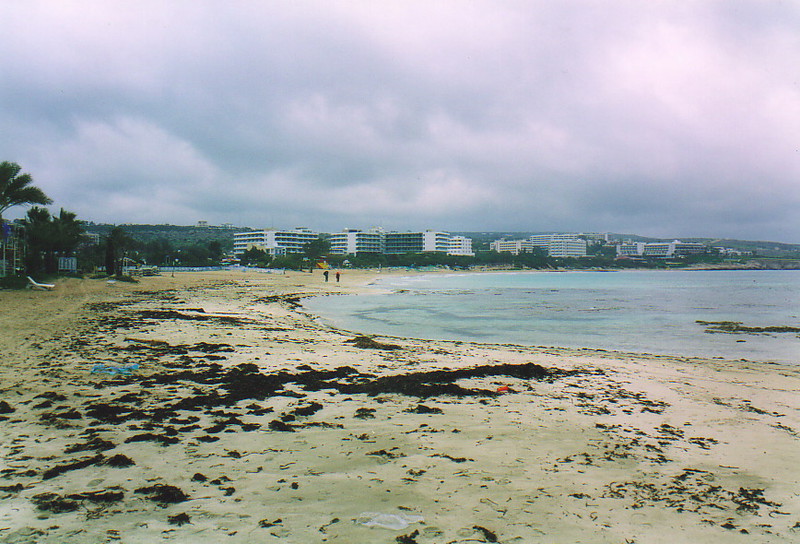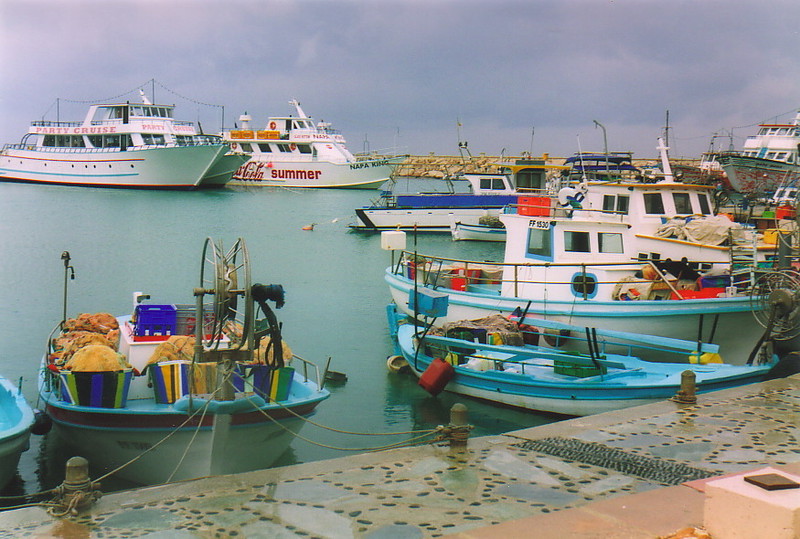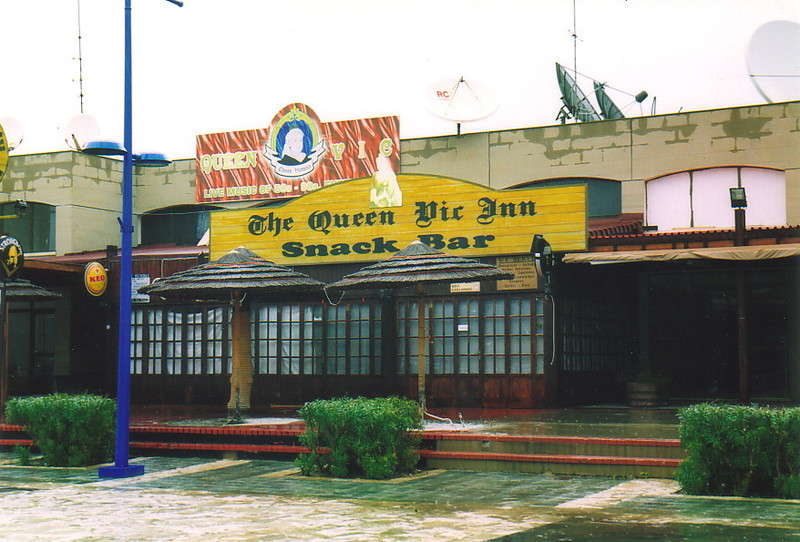
It didn't matter to us that Agia Napa1 is stuck right out on the remote southeast coast of Cyprus, a long way from anywhere else, and neither did it bother us that we'd chosen the coldest and wettest February on record to visit it. We didn't care because we weren't coming to Agia Napa to lie on the beach, get bombed and embarrass ourselves in a pool of vomit; instead, we were going there to see others do it. If there's one thing Agia Napa has, it's a reputation for utter hedonism, and where hedonism thrives, hilarity is sure to follow.
Unfortunately, February isn't the greatest time to be visiting Agia Napa in search of nightlife; indeed, it's a terrible time to be searching for any kind of life in Cyprus's clubbing Mecca, because out of season Agia Napa has more in common with wintry Blackpool than larging it in the Med. In fact, it's downright turgid, and is all the more fascinating for it; wandering around the ancient ruins of Pafos and Kourion, you find yourself picturing the scene with the ruins brought to life, full of Romans and Greeks worshipping their gods and gorging themselves at legendary banquets... and wandering around off-season Agia Napa, you find yourself picturing the scene overrun with thousands of pissed teenagers, worshipping at the altars of McDonald's, Stella and Pasha.

The scene I managed to imagine looked pretty good, to be honest. OK, you're not going to enjoy Agia Napa unless you're on a mission to pull, dance, drink, sunbathe and stay up all night, but assuming that's your bag, Agia Napa looks like a pretty pleasant place to do it. The bay curves round beautifully, facing south into the sun, and if you manage to get a room at one of the monstrous hotels lining the beach, life couldn't be simpler; you can fall out of bed and practically land on the beach, and once you've got your spot for the day, it's no more than a stone's throw to the largest collection of bars, restaurants and ATMs on Cyprus. Language is no problem, either; Agia Napa doesn't bother with that irritating Greek alphabet that you see all over Cyprus, and instead sticks to plain old English, the international language of the beach resort. You may see writing that looks like Greek, but on closer inspection it's nothing other than stylised runic English, written to look like Greek, but still inviting you in English to eat in Zorba the Greek's Restaurant, where you can choose from a massive menu that contains the usual favourites of egg, chips and burgers, along with just three Greek dishes, kleftiko, halloumi and, of course, kebab.
Chill-out Zone

If the summer is Agia Napa's Saturday night, then the winter is most definitely its Sunday morning. The whole place is asleep, and although there are signs of life, they're hard to spot, and they're a mile away from the foreign tourist trade. Agia Napa in the off-season is definitely a chill-out zone, sometimes literally.
When we visited, the appalling weather we'd been enjoying throughout our visit to Cyprus continued to bluster and freeze. The crescent beach, no doubt normally obscured by the bodies of thousands of lightly fried tourists, was utterly deserted, except for a forlorn cat who mewled pathetically from the shelter of a solitary plastic sun lounger; meanwhile the sea, surprisingly a pleasant light blue colour despite the grey skies, bashed into the harbour wall, lightly soaking the two huge pleasure yachts, the Party Cruise and the Napa King, that were moored up, biding their time for the coming tourist season. In the main pedestrianised street, the signs above the closed bars reflected in the rain-flecked puddles, proclaiming that not only could you enjoy the bar's happy hour, satellite sport, fast food and late night music, but that EastEnders would be shown on a full-screen TV. And even though the shutters were closed, the Queen Vic bar across the road looked just as enticing as Albert Square's favourite watering hole, and just as lively. The latter's reference was amazingly apt; as we wandered round the dormant streets of Agia Napa, it felt as unreal as a soap opera, and it didn't feel like a genuine clubbers' resort, it felt like a theme park, designed to give you the full clubbing holiday experience, all under one roof. Agia Napa, even in the off-season, feels like a parody of itself.

Amazingly, though, there were other human beings stumbling through the rain, though closer inspection of them and their cars showed them not to be foreign tourists, but Cypriot ones. Latching on to the signs of life like penguins huddling together in an Antarctic storm, Peta and I splashed our way to the Markos Restaurant right on the waterfront, no doubt a heaving mass of sun-cream-sticky plastic chairs in the summer, but now a friendly, cosy-looking restaurant that sported a healthy-looking number of clients and a roaring fire in the corner. Despite the list of available beers, which betrayed an obvious swing to north European mass tourism – John Smith's, Stella, Guinness, Heineken, Becks, Budweiser, Sol, Carlsberg and Fosters were on offer, but no Cypriot beers – the Markos was full of Cypriots, tucking into their Sunday lunches and obviously enjoying their rainy day out in Agia Napa. Unfortunately the fish we ordered was as tasteless as the modern architecture smothering the resort, and the projection TV showing Home and Away with Greek subtitles rather took the edge off any atmosphere the Markos might have mustered, but even though the average age of Agia Napa's winter clientele was at least double that of the summer, the place was still raving, in its own little way.
Come Down

I presume that driving north out of Agia Napa is something that few visitors bother to do; if they do, then they probably get as hopelessly lost as we did, and although I like a nice drive along the beach, it can get a little boring if you can't actually see the coast for hotels, fast food joints, and some stunning examples of why the architects who designed Cyprus's premier resort should be forced to explain themselves. Luckily we did end up eventually reaching the little town of Deryneia, some 10km north of Agia Napa, and I'm very glad we did.
It's interesting that Deryneia should be so close to Agia Napa, the chosen destination for holidaymakers who are only interested in the local culture if it wears a miniskirt and can down five double vodkas without chucking a whitey. 10km is not far, but Deryneia is right on the border with Turkey-occupied Northern Cyprus, and as with Nicosia, it's an amazing place to contemplate the fundamental divisions that split Cyprus in two.
As we drove into Deryneia, the weather seemed to get even bleaker, and by the time we pulled into the car park at the Cultural Centre for Occupied Ammochostos, the wind chill was utterly harrowing. Climbing the stairs onto the roof of the Cultural Centre was challenging, but it was worth it, for in the distance, blurred by the rain, was the abandoned suburb of Varosha, a symbol of how utterly devastating the partition of Cyprus has been.

By the mid-1960s, the town of Famagusta (now known to Greek Cypriots as Ammochostos) was one of Cyprus's most popular tourist destinations; Agia Napa was still just a little fishing village with a cute monastery, but Famagusta was a boom town, with hotels popping up all along the beautiful east coast of Cyprus, catering for the slowly increasing number of package tourists visiting the island. However Famagusta had traditionally been a stronghold for Turkish Cypriots, and throughout the turbulent late 1960s and early 1970s, the town suffered from a smorgasbord of Greek-Turkish tension. Finally, during the Greek coup and consequent Turkish invasion of 1974, Famagusta was the scene of serious fighting between Turkey and the Greek Cypriots, and although Famagusta is now in the Turkey-occupied north of Cyprus, the southern suburb of Varosha falls inside the UN-controlled buffer zone. The result is a whole section of the city that is uninhabited, and which looks exactly as it did when the ceasefire came into effect on .
From the roof of the Cultural Centre in Deryneia, you can see Varosha, just beyond a few green fields that mark the border between Cyprus and the occupied north. It's utterly eerie; Varosha is a ghost town, and with binoculars you can look at the remains of the 33 abandoned hotels lining the coast, crumbling slowly while rusting cranes still stand alongside buildings that were half built when everything kicked off back in 1974, and which remain in the same state today. Battered windmills gently turn in the dead zone, almost all of their sails missing, and it's easy to kid yourself that you're witnessing the aftermath of some horrible industrial disaster, or the effects of a nuclear winter. Varosha looks like something out of a particularly bleak episode of Doctor Who, especially on a windy day with the rain lashing down on this forgotten corner of Cyprus.
It's no wonder mass tourism doesn't venture this far north, really. Deryneia represents a hard dose of reality while Agia Napa represents utter escapism, and it's no coincidence that the latter is by far the biggest draw-card in Cyprus, while most visitors blissfully ignore the Green Line. The politics of Cyprus is hardly the stuff of which happy holidays are made, though for those with an eye on history rather than hedonism, its effects are more profound than any number of peach schnapps chasers.
1 Before the government changed the names of places in Cyprus, Agia Napa was written Ayia Napa, which is the way most tour operators write it, the way most dance compilations write it, and the way you say it. Agia is pronounced 'Aye-ee-ah' and is Greek for saint, ironically enough given Agia Napa's image.